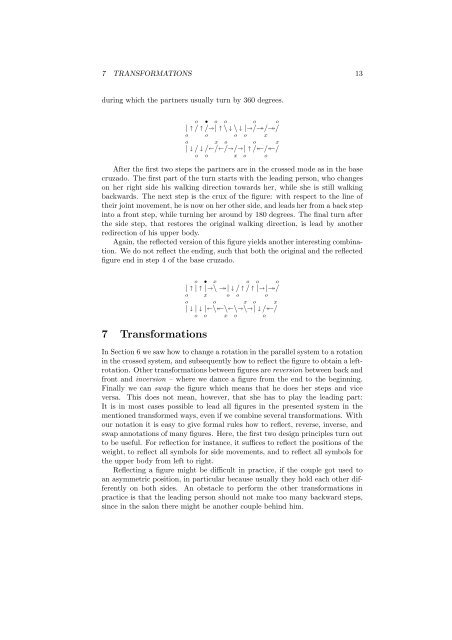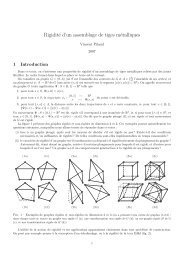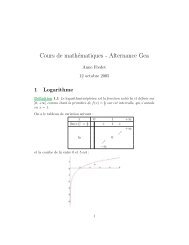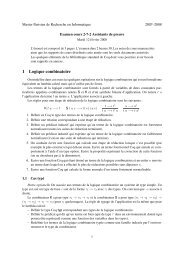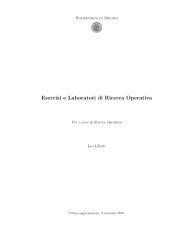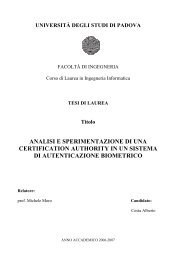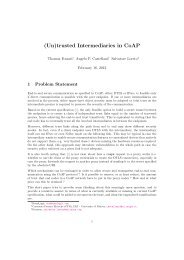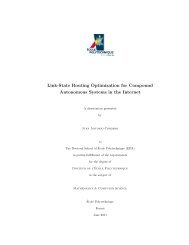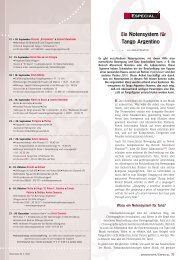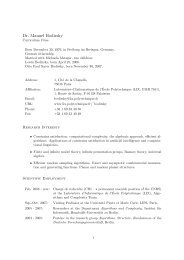You also want an ePaper? Increase the reach of your titles
YUMPU automatically turns print PDFs into web optimized ePapers that Google loves.
7 TRANSFORMATIONS 13<br />
during which the partners usually turn by 360 degrees.<br />
| <br />
o<br />
o<br />
/ •<br />
/ <br />
o<br />
o<br />
| o<br />
\\ | <br />
o o<br />
o<br />
/։/ ։<br />
x<br />
o<br />
/<br />
o<br />
| / / <br />
o o<br />
x<br />
/ o<br />
// | <br />
x o<br />
o<br />
/և/ և<br />
o<br />
x<br />
/<br />
After the first two steps the partners are in the crossed mode as in the base<br />
cruzado. The first part of the turn starts with the leading person, who changes<br />
on her right side his walking direction towards her, while she is still walking<br />
backwards. The next step is the crux of the figure: with respect to the line of<br />
their joint movement, he is now on her other side, and leads her from a back step<br />
into a front step, while turning her around by 180 degrees. The final turn after<br />
the side step, that restores the original walking direction, is lead by another<br />
redirection of his upper body.<br />
Again, the reflected version of this figure yields another interesting combination.<br />
We do not reflect the ending, such that both the original and the reflected<br />
figure end in step 4 of the base cruzado.<br />
7 Trans<strong>for</strong>mations<br />
| <br />
o<br />
o<br />
| •<br />
| <br />
x<br />
x<br />
\ ։| / <br />
o o<br />
o<br />
/ o<br />
|| ։<br />
o<br />
o<br />
/<br />
o<br />
| | | <br />
o o<br />
o<br />
\և\ \ <br />
x o<br />
x<br />
\ o<br />
| / և<br />
o<br />
x<br />
/<br />
In Section 6 we saw how to change a rotation in the parallel system to a rotation<br />
in the crossed system, and subsequently how to reflect the figure to obtain a leftrotation.<br />
Other trans<strong>for</strong>mations between figures are reversion between back and<br />
front and inversion – where we dance a figure from the end to the beginning.<br />
Finally we can swap the figure which means that he does her steps and vice<br />
versa. This does not mean, however, that she has to play the leading part:<br />
It is in most cases possible to lead all figures in the presented system in the<br />
mentioned trans<strong>for</strong>med ways, even if we combine several trans<strong>for</strong>mations. With<br />
our notation it is easy to give <strong>for</strong>mal rules how to reflect, reverse, inverse, and<br />
swap annotations of many figures. Here, the first two design principles turn out<br />
to be useful. For reflection <strong>for</strong> instance, it suffices to reflect the positions of the<br />
weight, to reflect all symbols <strong>for</strong> side movements, and to reflect all symbols <strong>for</strong><br />
the upper body from left to right.<br />
Reflecting a figure might be difficult in practice, if the couple got used to<br />
an asymmetric position, in particular because usually they hold each other differently<br />
on both sides. An obstacle to per<strong>for</strong>m the other trans<strong>for</strong>mations in<br />
practice is that the leading person should not make too many backward steps,<br />
since in the salon there might be another couple behind him.


